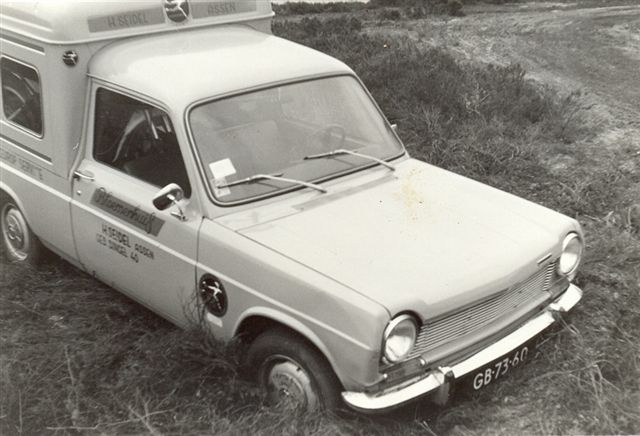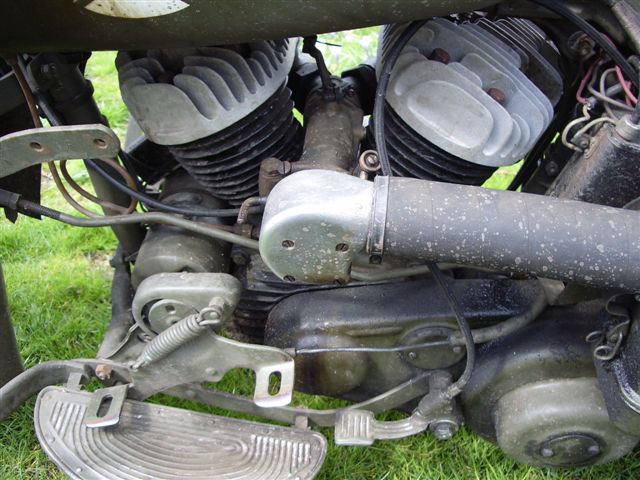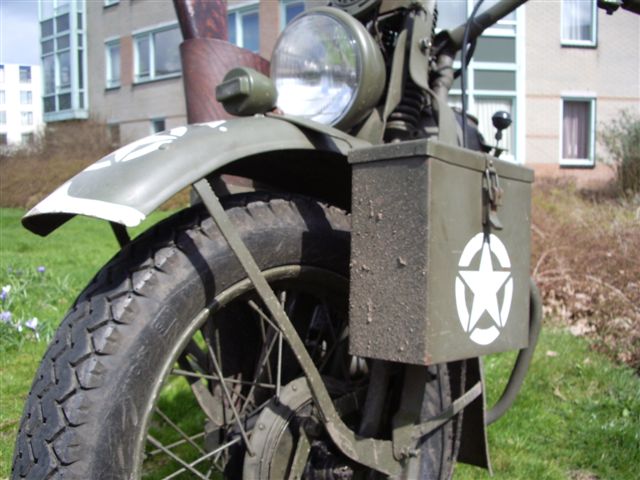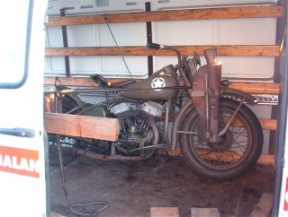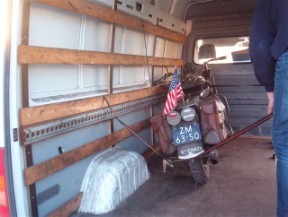|
In order to get the motorcycle moving, you operate the clutch with your left foot. You do this with both your heel and toes.
When declutched, the engine can be put into first gear and you can start riding.
The biggest problem is the left side. When you have to make a turn to the left, right after starting or make a curve, then this will be a problem.
Your knee is in the way and your balance will be truely be disturbed, it is very tricky.
Well, once you are on the move, you can gear up, into the second gear. You need to have a feeling for it and you will feel it as soon as it takes. Then you can go up to the highest gear, the 3rd.
Now you can exceed speed and go to cruising-speed. The motorbike will tell you what its cruisingspeed is. When your feet tremble from the foot board, then either you have it in the wrong gear or you are cruising with the wrong revolution.
Once you are used to this (and that may take quite some time) then you can pay attention to other things.
First you take the highway:
Try to avoid this road as often as you can. The motorbike has a topspeed of 105 km/h (65 mph) and the cruisingspeed is around 80-90 km/h (50-55 mph).
You can imagine that you don't feel comfortable here, when everybody passes you by with mega-speed. In 1942 bikers did not know this phenomena.
Greeting to other bikers is not possible here, you need to hang on to the steering rod.
Then take the b-roads:
This is where the bike feels more at ease, but you need to be aware of the dangers, to make emergency-stops (with barely any breaks, this is not an easy job).
So be on the look out for crossing dogs, tractors, kids and Opel-drivers etc. A Liberator is not made to give way to them.
Greeting other bikers on these kind of roads, is just possible.
Then take the clinker-roads:
Now that is crafty & dangerous. By the many holes and unevenness of the road-surface, speed that exceeds 50-60 km/h (30-35 mph) is irresponsable.
Remember that the fore-forks only have some suspension and on the rear part, suspension is not present.
The bike can beat viciously, both with the rearwheel as well as the frontside.
Now you really have to hold on to it, knees against the fueltank, feet stuck on the side-boards and God's blessing.
The ratteling of the springs will not fade, what a noise!
Greeting other bikers can not take place, due to security-reasons, which may be clear to you, no hard feelings about this.
If this has been succeeded then the sandpaths and other unhardened paths follow.
Then take the sandpaths and unhardened roads:
This is fun, the bike feels in its element here. One or other is adjusted in 2006 and is done with an appropriate speed, in order not to break things.
In wartime they didn't have a choise, in those days they won't have treated her gently.
If there has been talk of for instance a monsoon period or at least a long time of rainfall, these roads will be transformed into mudpools.
Now it is fun to wade through the mud, the mud and the water will be up till your knees. Your feet will be soaked in your bikerboots and you hope you can pass through and won't come to a fall.
The whole bike looks dreadful after a tour like this and that's how I personally think she looks best. Can't immagine things went differently in former days.
Those guys would not polish the bike after a long tour, was no use, because the next day she would be filthy again.
Strengthened by this thought, I never clean te bike. This is how it should be. Oil here and there on the engine-block, with stuck mud-remains, twiggs and grass makes her even look prettier.
This is how you can see, that the engine-block is hardly ever or never touched or tinkered with. An engineblock that is spotless an does not have any sign of leakage or use, they either don't drive with it or they are always polishing the bike, to remove every sign of leakage and remove it for the outerworld to fool them.
That is not what I'm like. I try to stay as close to reality, driving this type of motorcycle.
Then take the tresholds in the road-surface:
More and more the government is building speed-hindering objects in or on the road-surface, for a safe traffic-flow.
That this is not always without danger, I will point out here:
On a tour over the beautiful Frisian island of Ameland, on a certain moment I drove towards a village at cruisingspeed.
Now the ministry of traffic and public works had decided to place a treshold there, in order to reduce speed, when entering the village.
Obviously I could not reduce speed that quick and I drove with cruising speed over this obstacle.
At that very moment I felt the rear side of the bike jump up, through the saddlepin and this blow ended in my jaws with a good crack.
That was frightening, my complete backbone was jumbled and my jaw was a bit stangely situated on my head.
First took a break and rolled a cigarette to calm down. Carefully and very slowly I drove back to the camping Duinoord and took it easy the rest of the day.
Taking trasholds that are seen in time:
After this expreience on Ameland:
When you spot a treshold or other hole/obstacle in de road-surface:
You stand on the sideboards, raise the bottom of the driver a few centimetres from the saddle, adjust speed and try to take this object, without damage to human or machine.
Take the use of brakes:
It is common knowledge, there is really not a Harley-Davidson that is provided with good brakes.
Possibly that with the newer types they have improved them, but in the year 1942 certainly not.
Using the brakes needs to be done with a forseeing glance. When it is known, where to stop, the driver can keep count with it by reducing speed already.
This is a matter of experience and a great mileage.
But when having to make an emergency-stop, you need the help of Gods and hope that you stand stil in time.
Until today I did not need to and I hope I don't have to either in the future.
Then the check, before the intention to go for a ride:
First you make sure that there is fuel in the fueltank. Oil in the righthand tank is checked by dipstick.
The level of the oil-content in the gearbox is checked. You turn the contact-key for a moment to see if the lights for the dynamo and the oil-pressure are burning.
That's all really. What you could do is have a stroll around the bike and check if all the parts are present, that were there with the last tour.
Sometimes it can happen, that you loose something, that is not tightened enough. Everything you dismount and mount on again, should be turned on very tight or should at least be glued together with for instance Loctite.
|
